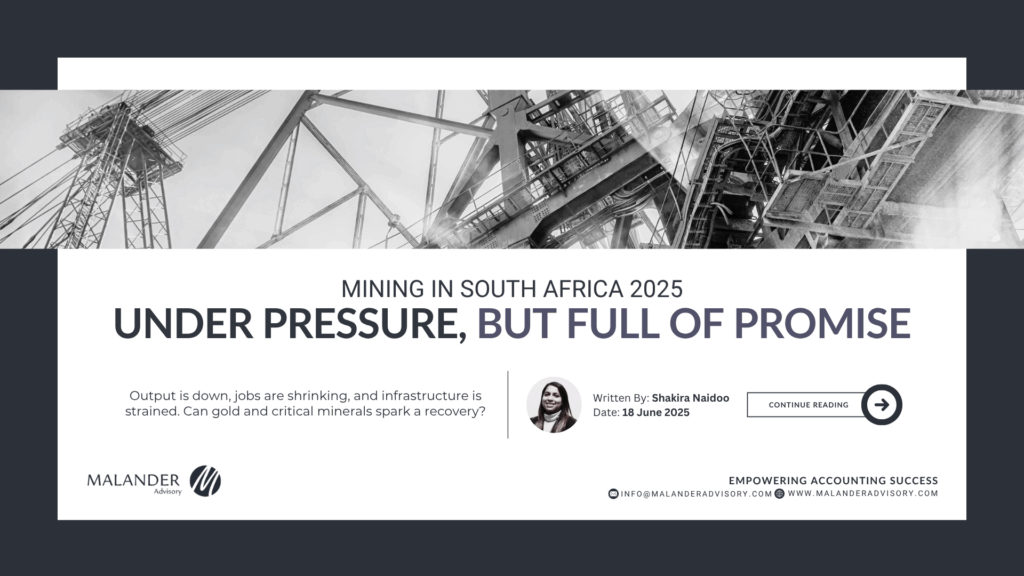Written By: Shakira Naidoo
Date: 18 June 2025
Introduction
South Africa’s mining industry remains a cornerstone of the national economy, yet in 2025, it faces a blend of structural challenges and evolving opportunities. Despite contributing around 6% of GDP in 2024 and employing nearly half a million people, the sector is grappling with production declines, infrastructure weaknesses, and a volatile commodity market. At the same time, rising gold prices and a strategic pivot toward critical minerals may offer a path to recovery. This article reviews the latest trends and outlines the steps needed to revitalise the sector as of 28 May 2025.
Mining’s Economic Contribution in 2024/25
In 2024, mining contributed approximately 6% of South Africa’s GDP. However, production remained weak heading into 2025. The country lost nearly 13,000 mining jobs last year, bringing direct employment down to about 469,000. In Q1 2025, production contracted significantly, with total mining output declining nearly 10% year-on-year in February alone. Platinum group metals (PGMs) and nickel were especially hard hit, with 18–25% output drops.
Diverging Commodity Fortunes
South Africa is the world’s largest producer of PGMs, but these commodities have struggled since 2023. Despite a minor recovery in early 2025, prices remain low, demand remains uncertain, and producers are cautious. This has led to job cuts and weakened tax contributions. The National Treasury projects a 28% decline in mining corporate tax revenues for FY 2024/25.
Conversely, gold has emerged as a bright spot. Record global prices have led to significant earnings boosts. Harmony Gold, for example, saw average prices jump 23% year-on-year in late 2024, driving a 40% surge in earnings. Silver prices also climbed by over 21% last year. These developments have helped stabilise export revenue and tax income, partly offsetting losses from the PGM slump.
Regulatory Reform and Investor Confidence
South Africa’s regulatory environment has historically discouraged exploration and project development. More than 5,000 mining and prospecting rights remain backlogged. Processing times have stretched beyond 18 months, driven by the outdated SAMRAD system.
Reform efforts are underway. In early 2024, a Canadian-led consortium was contracted to implement a new digital mining cadastre. The first rollout is expected in the Western Cape by July 2025, with other provinces to follow. The Department of Mineral Resources and Energy (DMRE) and the Minerals Council both cite this as a key turning point. President Ramaphosa and industry stakeholders have emphasised the urgency of clearing the backlog to attract exploration capital.
Additional reforms include the pending Mineral Resources Development Bill and the adoption of a Critical Minerals Strategy. These initiatives aim to stabilise policy, accelerate permitting, and promote domestic mineral beneficiation.
Power and Transport Constraints
Load-shedding continues to disrupt operations. Mines lost an estimated 12% of planned production time in 2024 due to rolling blackouts. Some mines have adopted on-site solar to reduce dependency on the grid, but power reliability remains a key constraint.
Transport infrastructure is also under strain. Transnet’s freight rail network, essential for bulk commodity exports, is performing below capacity. The iron ore line operated at only 54% efficiency, and coal shipments through Richards Bay fell 22% in 2024. Cable theft, aging infrastructure, and poor management continue to limit export volumes.
The government is pursuing public-private partnerships to upgrade rail corridors and ports. Concessions and investment in port equipment are in progress, but timelines for results remain uncertain.
Growth in Critical Minerals
Amid PGM volatility, South Africa is repositioning itself as a key player in the global energy transition through its critical mineral reserves. Vanadium, lithium, rare earth elements, and manganese are gaining prominence.
South Africa is the world’s second-largest vanadium producer. Projects like Bushveld Minerals’ Vametco expansion and Vanadium Resources’ Steelpoortdrift project are advancing, with construction expected in late 2025. These developments align with government goals to add value through battery-grade electrolyte production.
Lithium exploration is also underway. The Blesberg project in the Northern Cape began pilot production in early 2025. While relatively small, it marks South Africa’s entry into lithium production. Other junior firms are exploring additional pegmatite zones and rare earth prospects.
Path Forward
To revitalise the mining sector, five priorities must be addressed:
- Streamline regulation: Fully deploy the digital cadastre and clear the backlog. Ensure policy stability and competitive mining legislation.
- Fix infrastructure: Accelerate power and rail upgrades. Enable mines to invest in self-generation and improve Transnet’s operational efficiency.
- Promote exploration: Boost investor confidence with faster permitting, stable tax policies, and transparent environmental governance.
- Enhance beneficiation: Leverage critical mineral resources for in-country value-addition, especially in battery components and clean energy technologies.
- Support social and environmental sustainability: Foster inclusive growth, upskilling, and community development alongside environmental stewardship.
Conclusion
South Africa’s mining sector in May 2025 is defined by both strain and potential. Weak PGMs, load-shedding, and regulatory bottlenecks continue to weigh on growth. But the surge in gold prices, investment in vanadium and lithium, and long-awaited reforms offer hope. If policymakers can deliver on infrastructure upgrades, regulatory certainty, and value chain development, mining can reclaim its role as a driver of inclusive growth and transformation. The foundation remains strong. What matters now is execution.
Malander Advisory partners with mining entities across South Africa to provide strategic finance, and advisory solutions that enable sustainable growth in a complex operating environment.

